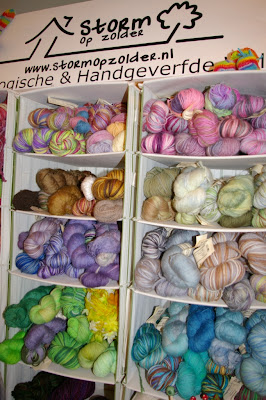
Het was de afbeelding op internet van het Japanse magazine New Style of Heirloom Knitting (op de foto middenboven) die de vonk deed overslaan: de prachtige trui met een slinger van eikeblaadjes en Ierse motieven stond meteen op mijn verlanglijstje.
De desbetreffende blog, Montreal Knits, toonde nog meer modellen uit deze uitgave en ik was helemaal verkocht. De websites van YesAsia en Amazon Japan werden en worden druk geconsulteerd.
Ook andere sites hebben een aanbod van tijdschriften, o.a. Saucy Louise, Felt Cafe en Chocolate Swirl.
It was a picture on the internet of the Japanese magazine New Style of Heirloom Knitting (at the top of the picture above) that sparked my attention: the beautiful sweater with a motif of leaves and acorn and Irish knitting was instantly on my "to make"-list .
The relating blog, Montreal Knits, showed more patterns from this edition and I was hooked. The websites of YesAsia and Amazon Japan were and are still eagerly consulted!
Other sites are also selling the magazines, like Saucy Louise, Felt Cafe and Chocolate Swirl.
De desbetreffende blog, Montreal Knits, toonde nog meer modellen uit deze uitgave en ik was helemaal verkocht. De websites van YesAsia en Amazon Japan werden en worden druk geconsulteerd.
Ook andere sites hebben een aanbod van tijdschriften, o.a. Saucy Louise, Felt Cafe en Chocolate Swirl.
It was a picture on the internet of the Japanese magazine New Style of Heirloom Knitting (at the top of the picture above) that sparked my attention: the beautiful sweater with a motif of leaves and acorn and Irish knitting was instantly on my "to make"-list .
The relating blog, Montreal Knits, showed more patterns from this edition and I was hooked. The websites of YesAsia and Amazon Japan were and are still eagerly consulted!
Other sites are also selling the magazines, like Saucy Louise, Felt Cafe and Chocolate Swirl.

Maar hoe weet ik nu welke magazines mij interesseren? De vorige 3 links zijn behulpzaam maar de meeste informatie haal ik uit de volgende blog: http://tw.myblog.yahoo.com/snowy-mavisy/article?mid=663. Hierop worden regelmatig uittreksels uit de nieuwe tijdschriften gepubliceerd, zo heb je een indruk van wat je kan verwachten.
Oh ja, en knitting (nitsuto) betekent voor Japanners soms terzelfdertijd breien en haken, het verschil is minder rigoureus.
But how do I know which magazines are interesting to me? The former 3 links are helpful but most information I get from the following blog:
http://tw.myblog.yahoo.com/snowy-mavisy/article?mid=663. It shows excerpts from the new books, so you can get an impression what to expect.
Oh and by the way, knitting (nitsuto) often means knitting and crochet in the same time, the Japanese do make less difference between them.

Waarin ligt nu de aantrekkingskracht van de Japanse breimodellen?
De meeste patronen zijn zo goed gestileerd en evenwichtig dat je bij het inkijken van een magazine direct zin krijgt om de modellen te verwezenlijken, een uitstekend criterium voor de kwaliteit van een breiboek. Bovendien zie ik regelmatig steken die in Europa niet gekend zijn; het is een wonderlijke eigenschap van Japanse ontwerpers om zich te laten inspireren door Westerse technieken of motieven, er de essentie uit te halen en een uitgepuurde, vernieuwende versie naar voren te brengen.

Maar is Japans breien en haken dan niet ingewikkeld en alleen weggelegd voor gevorderde "knitaholics"? Niet echt, de patronen worden met schema's en tekeningetjes verduidelijkt. Met de hulp van volgende sites en een beetje speurzin kunnen ook gemiddelde breisters er zich aan wagen. En er zijn hele leuke kleine modellen; zo zag ik onlangs nog een gebreid broodmandje, echt "kawaii" (Japans voor schattig, cute).
Allereerst is er de onvolprezen Yahoogroep Knitting in Japan, een echte goudmijn van informatie.
Voor het begrijpen van de gebruikte symbolen zijn er 2 essentiële sites:
http://www.jessica-tromp.nl/knittingpatterns_breipatronen/japanese_stitches_japanse_breisteken.htm
en
http://www.tata-tatao.to/knit/e-index.html

Wherein lies exactly the attraction of Japanese patterns?
Most of them are so exquisitely styled and balanced that on the first glance you would love to start knitting them as soon as possible, an excellent criterion for the quality of a knitting book. Besides I often discover stitches unknown in Europe; it is a surprising gift of Japanese designers to be inspired by Western techniques or patterns, to extract the essence from them and to bring out a refined and innovative version.
But then are Japanese knitting and crochet not too complicated and only for serious "knitaholics"? Not exactly, the patterns are made more clear by charts and drawings. Following sites are a big help and with a bit of flair average knitters will be succesful too. And there are a lot of nice small projects; lately I saw a tiny knitted bread-basket, really "kawaii" (cute in Japanese).
First of all there is the excellent Yahoogroup Knitting in Japan, a real gold mine of information.
To understand the meaning of the different symbols there are two essential sites:
http://www.jessica-tromp.nl/knittingpatterns_breipatronen/japanese_stitches_japanse_breisteken.htm
and
http://www.tata-tatao.to/knit/e-index.html
Moge de Japanse brei- en haakpublicaties nog lange tijd voor inspiratie zorgen! Uit mijn volgende post zal blijken dat ik mij daarover voorlopig geen zorgen hoef te maken.
May the Japanese knitting and crochet publications be a long lasting source of inspiration! My next post will prove that I don't have to worry about that yet.






































